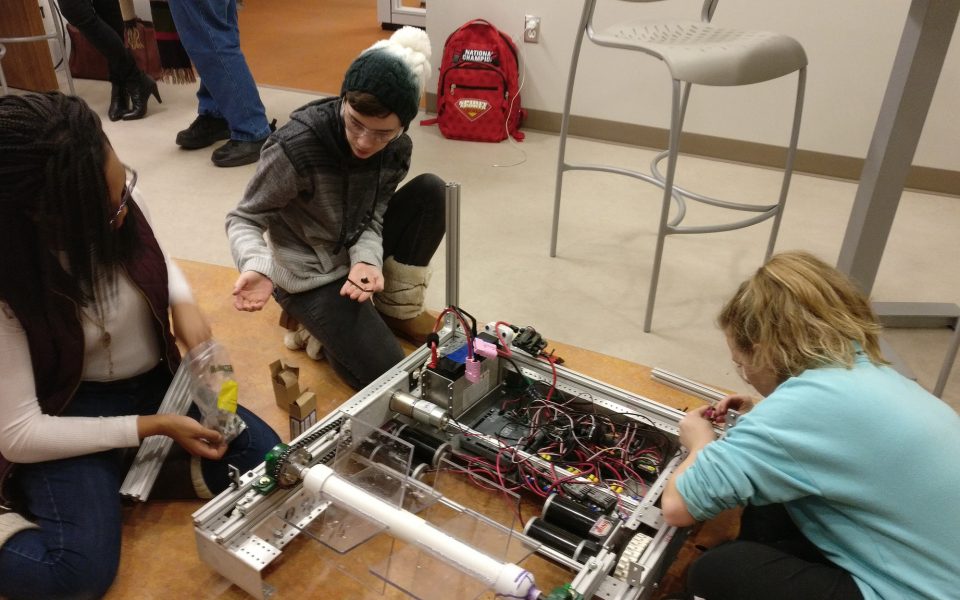Hundreds of people packed the stands and floor of UNCG’s Fleming Gymnasium back on March 10 and 11, while others watched anxiously from designated pit areas. Six teams took the court at a time, forming rival alliances of three teams each. The intense, two-and-a-half-minute matches marked the first contest of the season for Girls on Fire, and the competition was hard on everyone. Even the robots.
The 20 high-school students who make up Girls on Fire competed as a FIRST Robotics Competition team — the only all-girls team in the Triad and one of only two in the state. FIRST (For the Inspiration and Recognition of Science and Technology), a worldwide nonprofit, encourages the pursuit of education and careers in science, technology, engineering and math, while building confidence, understanding and life skills.
In early January, all participating teams received information regarding the rules and tasks involved in this year’s competition, as well as a very spare starter kit of parts. They had six weeks to conceptualize, design, program and build their robots, and then couldn’t return to their creations until the tournaments started.
For this year’s competition — FIRST Steamworks — teams faced off in a simulation of airship-travel preparation, which included tasks that represented collecting fuel to build steam pressure, installing gears to engage rotors and, finally, ascending their robots onto the ship.
Twenty-six teams from the Triad, Charlotte, Hillsborough, Durham and other North Carolina cities came to UNCG for the first of several district contests that would determine who qualified for the state championship at Campbell University on April 1 and 2. For Girls on Fire coach Melissa Bube, her team’s inaugural competition felt like a mix between participating in a state basketball tournament and a comic-con. The FIRST competitions have all the emotion attached to more familiar games, but they’re the alternative reality of sports Bube has always wanted.
“[The contests are] less about physical prowess and more about team’s problem-solving skills and engineering acumen,” said Bube, an employee at the technology company Inmar, a sponsor of Girls on Fire. “All teams are focusing on helping each other out so that everyone can get better and perform better.”
But on the court in Greensboro, Bube’s team was in trouble. Originally they had designed a robot to resemble a waterwheel: A central cylinder with paddles that stuck out in order to gather whiffle balls (or “fuel”) to then shoot into boilers — the task that resembled building steam pressure for the airship.

©
Unforeseen to the team, the paddles impacted the robot’s ability to climb into the ship, an important achievement in terms of overall points. Ultimately unable to board their robot onto the airship, Girls on Fire didn’t perform up to its expectations on the home court.
But more than anything involved in the competition, the high schoolers’ resolve going into the next district contest in Asheville impressed Bube.
“They took that experience and debriefed: What they should stop doing, keep doing and do better,” she said. “All the students rallied and channeled their energies into performing at their utmost.”
Before the next round of competition, Girls on Fire made the choice to cut off the paddles and wrap the axle in velcro in order to help maneuver the robot up the rope and into the ship.
On the court in Asheville, the robot’s ascent started off well.
“The robot had started to climb, and the ropes are only lowered in the last few seconds, so you could hear people going, ‘Climb, climb, climb!’” Bube said. “But then the knot [at the top of the airship] slipped through the hole and the rope and robot fell.”
In that alarming moment, members of other teams ran over to offer their assistance to their opponent.
“The robot ended up being fine, but I know the students really appreciated the potential help and encouragement,” Bube explained. “It showed how encouraging and inclusive and open for achievement everyone is.”
Their robot unharmed, Girls on Fire went on to finish the Asheville competition on the winning alliance and qualify for the state championship at Campbell University. But this year, their road ended there; the all-girls team didn’t advance from the state tournament to the world championship in St. Louis.
[pullquote]Pullout: Visit girlsonfire5679.com for more information on how to get involved with Girls on Fire and the FIRST Robotics Competition.[/pullquote]
Fearful moments like the robot’s fall have been some of the most educational for Girls on Fire members like Dani Coan — an 11th grader at Early College of Forsyth in Winston-Salem.
“I’ve learned how to deal with mistakes and realize that nothing is going to be perfect,” Coan said. “The beautiful thing about engineering is that there is something that can always be improved. I love the spirit of constant innovation and improvement on Girls on Fire.”
For Coan’s teammate McKenna Slozer, an 11th grader at RJ Reynolds High School in Winston-Salem, her experience may lead her into a career.
“I have learned about coding, making web pages and safety,” Slozer said. “The team helped me find what I want to do in life… I want to keep doing robotics and animatronics.”
For many of the Girls on Fire, their experience has come to represent the mission of their team name: A way to show their empowerment and excitement for the game and for what lies ahead in the world of science.

©
Join the First Amendment Society, a membership that goes directly to funding TCB‘s newsroom.
We believe that reporting can save the world.
The TCB First Amendment Society recognizes the vital role of a free, unfettered press with a bundling of local experiences designed to build community, and unique engagements with our newsroom that will help you understand, and shape, local journalism’s critical role in uplifting the people in our cities.
All revenue goes directly into the newsroom as reporters’ salaries and freelance commissions.


Leave a Reply